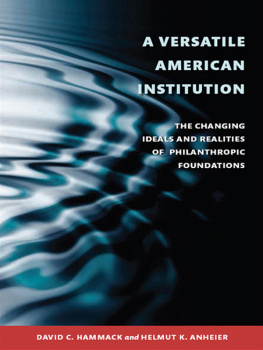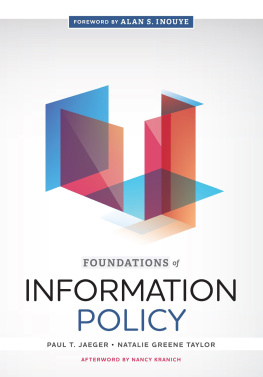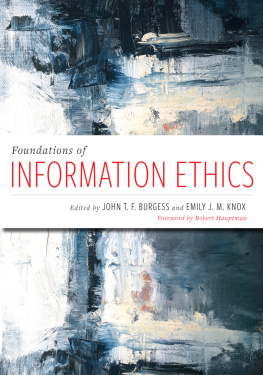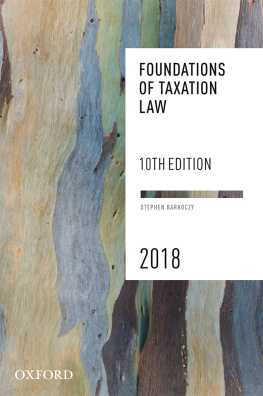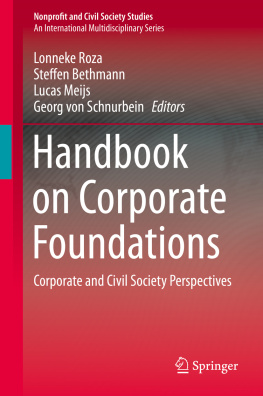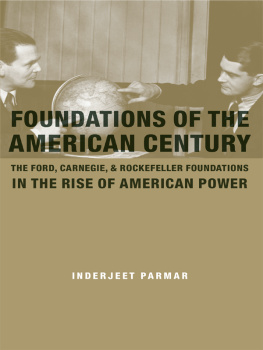ABOUT BROOKINGS
The Brookings Institution is a private nonprofit organization devoted to research, education, and publication on important issues of domestic and foreign policy. Its principal purpose is to bring the highest quality independent research and analysis to bear on current and emerging policy problems. Interpretations or conclusions in Brookings publications should be understood to be solely those of the authors.
Copyright 2013
THE BROOKINGS INSTITUTION
1775 Massachusetts Avenue, N.W., Washington, D.C. 20036
www.brookings.edu
All rights reserved. No part of this publication may be reproduced or transmitted in any form or by any means without permission in writing from the Brookings Institution Press.
Library of Congress Cataloging-in-Publication data
Hammack, David C.
A versatile American institution : the changing ideals and realities of philanthropic foundations / David C. Hammack and Helmut K. Anheier.
pages cm
Includes bibliographical references and index.
ISBN 978-0-8157-2194-9 (pbk. : alk. paper)
1. EndowmentsUnited StatesHistory. I. Anheier, Helmut K., 1954 II. Title.
HV97.A3H36 2013
361.7'6320973dc23
2012042363
9 8 7 6 5 4 3 2 1
Printed on acid-free paper
Typeset in Adobe Garamond
Composition by Cynthia Stock
Silver Spring, Maryland
Printed by R. R. Donnelley
Harrisonburg, Virginia
Preface
C ontentious debates about foundations continue in the United States and elsewhere. Americans argue about what foundations can do and how they should be regulated and taxed. Europeans express differing views about the possible uses of foundations to advance civil society and to encourage more flexible responses to public problems, opinions that resonate in regions as different as Australia, Latin America, or Japan. In Russia, parts of Asia, and throughout much of the Middle East, foundations are seen by some as a sign that a modernizing society is coming of age, but are viewed by others as politically controlled islands of privilege. These debates are distinct, of course, yet they are also closely related, as they focus on a common ideal: a notion of the American foundation. Indeed, some leading American foundations promote the view that foundations can do much for civil society and the public good in any part of the world. European, Australian, and Japanese commentators refer to American foundations as they advance varying views about the current relevance of their own foundations.
With this book we hope to contribute to both American and international debates by examining what American foundations have actually accomplished and by considering what they might be able to do in the coming decades. The book is a double experiment. We have sought to combine the perspectives of an historian and a social scientist to identify facts and realities in ways that will be widely useful to policy debate. Facts and realities are always contested, but we think we have developed a fair and comprehensive account.
American and international discussions of foundations can be highly charged. Sharply focused advocates of effectiveness and of equality have energized the American debate in recent years as they compete for influence in legislatures, courts, board rooms, and in the minds of donors. Not infrequently they also engage with polemicists committed to other aims as well as with foundation defenders and apologists. The sometimes quieter European debate, often focused on the proposed European Foundation Statute, is taking place as Europeans confront continuing financial and political challenges to redefine their ideas about state, nation, and private initiative. By contrast, the politically charged role of foundations in the Middle East or Russia reflects unsettled and divisive notions about what their place should be, in what kind of society. We seek to introduce a sense of proportion and reality into these debates. We also hope to show how history can add valuable dimensions to the policy discussions, and also how concern about an important current issue can lead historians to reconsider their understandings about the past.
This is one of several volumes commissioned by the Aspen Institute's Program on the Nonprofit Sector and Philanthropy. Our first book in the series, American Foundations: Roles and Contributions, an edited collection, brings together eighteen essays by twenty-six leading specialists on foundations in specific fields. In this second volume, we offer a concise and synthetic historical discussion of what American foundations have done, as well as a distinctive assessment of the ways changing American contexts have changed foundations.
In A Versatile American Institution we consider foundations in a new way. Unlike previous general accounts we do not focus narrowly on foundations, their donors and their leaders, asking what they have intended to do, or whether we approve. Instead, to echo Waldemar Nielsen, we ask what sort of strange or improbable creature the foundation might be and how it fits into the great jungle of American democracy and capitalism. We consider foundations as institutions in the contexts of their times and in the contexts of their communities. We focus on foundations as participants in the fields they address and we acknowledge from the outset that they may often be minor participants.
Society and policymakers will continually ask what foundations are good for and how we should regulate them. This book accordingly seeks to determine what foundations can actually do and what they have actually done with their independently controlled wealth. We propose that careful attention to historical context and to the many recent studies of foundation effectiveness can help us understand what foundations can contribute and to think realistically about how we can best evaluate them.
This volume differs from most accountsand from most historical studies of the subjectby considering the full range of foundations. We have adopted this approach because the broad basic legal definition used by the Internal Revenue Service necessarily shapes American policy debates. As the IRS puts it, a foundation has a single major source of funding (usually gifts from one family or corporation rather than funding from many sources) and engages primarily in the making of grants to other charitable organizations and to individuals, rather than the direct operation of charitable programs. The IRS adds the general summary of U.S. law that charitable tax-exempt organizations pursue purposes that are charitable, religious, educational, scientific, literary, testing for public safety, fostering national or international amateur sports competition, and preventing cruelty to children or animals. It goes on to state that the term charitable is used in its generally accepted legal sense and includes relief of the poor, the distressed, or the underprivileged; advancement of religion; advancement of education or science; erecting or maintaining public buildings, monuments, or works; lessening the burdens of government; lessening neighborhood tensions; eliminating prejudice and discrimination; defending human and civil rights secured by law; and combating community deterioration and juvenile delinquency. Elsewhere, the IRS makes clear that a foundation is an autonomous, nongovernmental organization controlled by its own board.
Because we start with this very broad legal definition, we avoid the usual undue focus on only the very largest, national, general-purpose foundations that date from the last decades of the nineteenth century and the first decades of the twentietha small group of foundations associated with such names as Peabody, Carnegie, Rockefeller, Rosenwald, Guggenheim, Ford, and Gates. We do not ignore these very large foundations; they have been most fully studied and their size and enterprise deserve attention. But they are not typical of the entire field. The work of many other foundations is poorly documented: we have looked hard for evidence about them and found a good deal of neglected material, but we are aware that in many cases we can only raise questions and suggest further study. Within the limits of available knowledge and of our resources we make a concerted effort to take a comprehensive view, to consider foundations of all kinds and foundations that pursue any of the purposes subsumed under the IRS definition.

